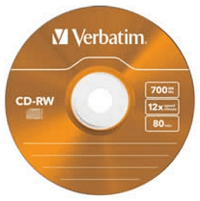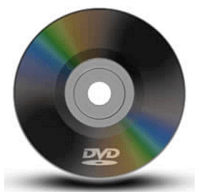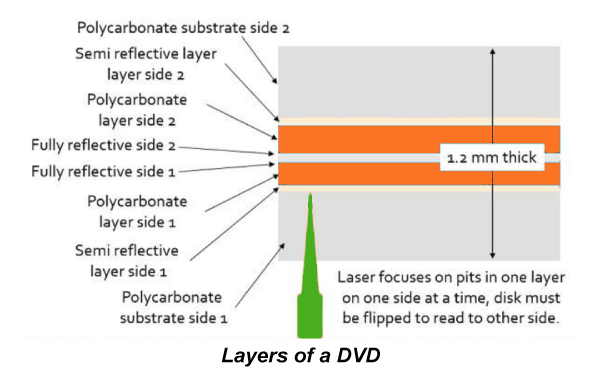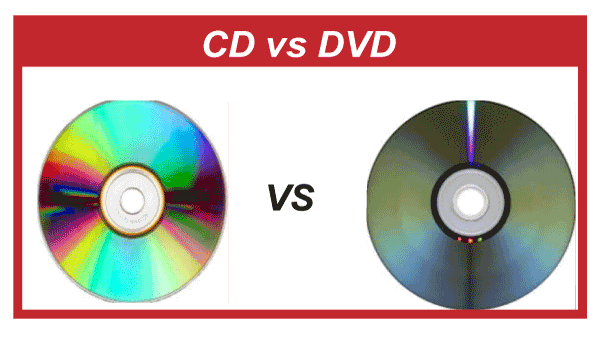CD and DVD both are essentially two different forms of an optical disk, each with a large storage capacity and high-quality definition. Their manufacturing methods and sizes distinguish them. A normal DVD can carry far more data than a CD. It’s because CDs only have a polycarbonate substrate on one side. On the other hand, it can be found on both sides of a normal DVD. This article will cover the differences between CD and DVD in-depth. But first, let us get to know them individually.
Optical technology is used in both DVDs and CDs. We can extract data using light, particularly lasers, in this case. We focus a laser beam on the DVD or CD to read the data that the disk stores in the form of bits and then write the available content.
What is CD?

The term CD stands for Compact Disk. This technology was the first step in the field of digital information coding, which makes use of a novel coding methodology. A 14-bit code represents a computer memory unit in a CD. This coding method also aids in the error detection process. For a long time, the CD served as an adequate substitute for memory devices. It’s because they used to provide a low-cost solution for those who needed to store large amounts of data or media.
The Compact Disk (CD) was the first step toward the concept of digital data encoding. It uses a unique method of encoding in which a 14-bit code indicates a byte, and this encoding technique also aids in error detection. It was an appropriate alternative for the magnetic disk as it offered a low-cost solution for storing large amounts of data.
The data is stored in the indented pits of the CD’s first layer, which is made of polycarbonate plastic. A clear glass base is also provided by this layer. The term “land” refers to a region that is flat or unindebted. The programmed disk is protected by a thin layer of aluminium, which is subsequently covered by a protective acrylic coating. The disk is stamped with a label in the final section. The pits are arranged in a spiral track radiating outward from the disk’s centre, with the index information stored at the disk’s beginning to reduce the chance of damage. The pits’ length and width are 0.8-3 and 0.5 microns, respectively.
The stored bits are read by shining a laser light on the spinning disk’s polycarbonate portion. An indented portion of the disk reflects the light detected by the photodetector. Compact discs come in a variety of formats, including CD-R, CD-RW, and CD-ROM.
What is DVD?

The term DVD stands for Digital Versatile Disk. It includes a videotape that can be used in a tape recorder (sometimes called a Video Container Recorder) as well as fixed storage that can be used in a computer. In this case, a videodisc may carry nearly seven times more information than a CD. It can also acquire videos and media with excellent image quality, which users can access at any time. The material used to make a videodisc is comparable to that used to make a CD, but the construction procedures are different. As a result, the layers are also different per unit area. A DVD can be played on both sides. It corrects errors using EFMplus and RS-PC codes.

The dense packing of the bits, the use of a shorter wavelength laser, and the production of a two-sided disc are the reason for its larger size than a CD (data can be read from write to both sides). A short wavelength laser is used to obtain the smaller spacing of about 0.74 microns between the spiral tracks and the minimum distance of 04 microns between the pits.
On the standard layer, it has a dual layer of pits and lands, with a semi-reflective layer on top of the reflective layer. The laser must be accurately focused to read the layers’ content independently on DVD. DVD, like CD, has variations such as DVD-R, DVD-RW, etc.
Formats of DVD
Originally, DVD technology was based on three basic formats, the presence of which was governed by special requirements for various DVD applications: –
1. DVD-ROM
We used DVD-ROM to record data, including multimedia, used in computer technology.
- DVD+RW (It is based on CD-RW recording technology).
- DVD-RW (This disc can be rewritten in its entirety numerous times; however, certain information cannot be removed).
- DVD-RAM (incompatible with most playable devices, yet more durable and rewritten than other discs).
- DVD+R (Can be written once; no visible differences exist between it and DVD-R; nonetheless, a drive that reads DVD+R / RW will not be able to read DVD-R /RW and vice versa).
Difference Between CD and DVD

| Parameters | CD | DVD |
|---|---|---|
| Full-Form | The full-form of CD is Compact Disk. | The full-form of DVD is Digital Versatile Disk. |
| Size | A standard CD is around 700 MB in size. | A DVD’s size ranges from 4.7 to 17 GB. |
| Space present between Loops | In a CD, the total space between the spiral loops is approximately 1.6 μm. | In a DVD, the total space between the spiral loops is approximately 0.74 μm. |
| Spaces present between Pits | In a CD, the total spacing between the various pits is approximately 0.834 (micrometer) μm. | In a DVD, the total space between the various pits is around 0.4 m. |
| Layer of Recording | It has a metal layer or recording layer that is closer to the top of the given disc. | In this case, the metal layer, also known as the recording layer, stays near the disk’s middle section. |
| Total Layers of Pits | It just has one layer of pits. | It features two layers of pits in total. |
| Code of Correction | For error correction, CD uses the codes of EFMP and CIRC. | For error correction, DVD uses the codes of EFMplus and RS-PC. |
| Numeric Aperture | The numeric aperture of a CD is 0.45. | The numeric aperture of a DVD is 0.6. |
| Thickness | A CD is approximately 1.2 mm thick (millimetres). | A DVD is approximately 0.6 mm thick. |
| Length of Channel Bit | In CD, the channel bit length is 300 nm (nanometre). | In DVD, the channel bit length is 113nm. |
| Rate of data transfer | The rate of data transfer in a CD is 1.4 Mbps (Megabytes per second) to 16 Mbps. | The rate of data transfer is 11 Mbps. |
Key Differences Between CD and DVD
- On a standard CD, data is recorded in one layer, whereas on a DVD, data is recorded in two layers. Of course, a disc-like this contains a lot more information. CDs are significantly easier to defend against pirates than DVDs.
- Keep in mind the distinction between DVD-R and DVD-RW discs. The former can only be recorded once, but the latter can be deleted by writing something else in its place.
- A red laser is used to record on discs, which starts in the middle and gradually advances to the edge. Such a device is present in almost each personal computer and laptop.
- Discs are organised by genre, topic, and artist in our music store. We may rapidly locate the desired drive without having to search the full story. In addition, each disc has a brief description where we may learn about the artist and the record, as well as examine the output.
- A standard CD stores 700 MB of data, as we all know (much less often, there are discs with a capacity of 650, 800, and 900 MB). In this regard, DVD categorization is more diverse: the most common DVD-5 with a 4.7 GB size, DVD-9 (8.5 GB), DVD-10 (9.4 GB), unusual DVD-18 (17 GB), and HD DVD (up to 30 GB).
- Using a laser, information is recorded on a plastic base covered with a layer of metal-depression of various lengths are generated, which are organized in spirals in paths. A thin layer of varnish protects the plastic from harm while not interfacing with the beam’s passage.
- DVD+RW (It is based on CD-RW recording technology).
- DVD-RW (This disc can be rewritten in its entirety numerous times; however, certain information cannot be removed).
- DVD-RAM (incompatible with most playable devices, yet more durable and rewritten than other discs).
- DVD+R (Can be written once; no visible differences exist between it and DVD-R; nonetheless, a drive that reads DVD+R / RW will not be able to read DVD-R /RW and vice versa).
Difference Between CD and DVD

| Parameters | CD | DVD |
|---|---|---|
| Full-Form | The full-form of CD is Compact Disk. | The full-form of DVD is Digital Versatile Disk. |
| Size | A standard CD is around 700 MB in size. | A DVD’s size ranges from 4.7 to 17 GB. |
| Space present between Loops | In a CD, the total space between the spiral loops is approximately 1.6 μm. | In a DVD, the total space between the spiral loops is approximately 0.74 μm. |
| Spaces present between Pits | In a CD, the total spacing between the various pits is approximately 0.834 (micrometer) μm. | In a DVD, the total space between the various pits is around 0.4 m. |
| Layer of Recording | It has a metal layer or recording layer that is closer to the top of the given disc. | In this case, the metal layer, also known as the recording layer, stays near the disk’s middle section. |
| Total Layers of Pits | It just has one layer of pits. | It features two layers of pits in total. |
| Code of Correction | For error correction, CD uses the codes of EFMP and CIRC. | For error correction, DVD uses the codes of EFMplus and RS-PC. |
| Numeric Aperture | The numeric aperture of a CD is 0.45. | The numeric aperture of a DVD is 0.6. |
| Thickness | A CD is approximately 1.2 mm thick (millimetres). | A DVD is approximately 0.6 mm thick. |
| Length of Channel Bit | In CD, the channel bit length is 300 nm (nanometre). | In DVD, the channel bit length is 113nm. |
| Rate of data transfer | The rate of data transfer in a CD is 1.4 Mbps (Megabytes per second) to 16 Mbps. | The rate of data transfer is 11 Mbps. |
Key Differences Between CD and DVD
- On a standard CD, data is recorded in one layer, whereas on a DVD, data is recorded in two layers. Of course, a disc-like this contains a lot more information. CDs are significantly easier to defend against pirates than DVDs.
- Keep in mind the distinction between DVD-R and DVD-RW discs. The former can only be recorded once, but the latter can be deleted by writing something else in its place.
- A red laser is used to record on discs, which starts in the middle and gradually advances to the edge. Such a device is present in almost each personal computer and laptop.
- Discs are organised by genre, topic, and artist in our music store. We may rapidly locate the desired drive without having to search the full story. In addition, each disc has a brief description where we may learn about the artist and the record, as well as examine the output.
- A standard CD stores 700 MB of data, as we all know (much less often, there are discs with a capacity of 650, 800, and 900 MB). In this regard, DVD categorization is more diverse: the most common DVD-5 with a 4.7 GB size, DVD-9 (8.5 GB), DVD-10 (9.4 GB), unusual DVD-18 (17 GB), and HD DVD (up to 30 GB).
- Using a laser, information is recorded on a plastic base covered with a layer of metal-depression of various lengths are generated, which are organized in spirals in paths. A thin layer of varnish protects the plastic from harm while not interfacing with the beam’s passage.

